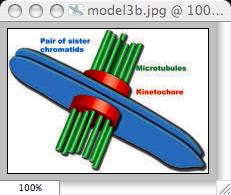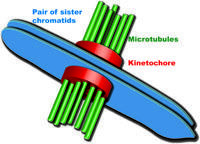Kinetochores-Microtubules-chromosomes
Cells divide throughout life to grow and renew tissues. During cell division, the genetic material (chromosomes) should be equally and accurately separated between the two daughter cells. Each human cell has 23 pairs of chromosomes. Errors in chromosome separation are often found in tumours.
My interest is to understand the mechanism by which chromosomes are captured by microtubules (imagine ropes capturing a bulky mass) and separated into two equal sets.
How do microtubules pull and push chromosomes during chromosome separation?
How is biochemical energy translated into mechanical movement of chromosomes?
These are the two fundamental and fascinating questions of my research work.
Background:
Microtubules (in green) capture chromosomes (in blue) in a stochastic manner via large multi-protein structures called ‘kinetochores’ (in red). Each human kinetochore attaches to 20-40 microtubules.
Microscopists had known for nearly 50 years that even a single incorrectly attached kinetochore is sufficient to pause the separation of all chromosomes within a cell. This way the cell makes sure that chromosomes do not permaturely separate before all of them are correctly attached to microtubules from opposite sides of the spindle. The molecular players essential for this pivotal error-check mechanism were revealed using yeast genetics. These are evolutionarily conserved 'checkpoint proteins' present in all cells from yeasts to humans. But the precise biochemical nature of the signal monitored by checkpoint proteins is not known. This is a puzzling and one of the hot questions in the field.
Another interesting question and my favourite one is the following: Since microtubule capture is stochastic, there must be error correcting mechanisms- i.e., to stablize correct attachments and to selectively lose wrong ones. Very few clues exist to describe this mysterious process as well.
To unravel how the proteins of the kinetochore signal incorrect attachment and coordinate mechanical movements, we first need to understand how the proteins of the kinetochore interact with microtubules.
I employ quantitative cell-biology assays to follow the dynamic movements of chromosomes during mitosis. I use molecular tools to analyse how the proteins of the kinetochore influence chromosome movement.
For more information on results, wait to see my paper or poster at ASCB :)

My interest is to understand the mechanism by which chromosomes are captured by microtubules (imagine ropes capturing a bulky mass) and separated into two equal sets.
How do microtubules pull and push chromosomes during chromosome separation?
How is biochemical energy translated into mechanical movement of chromosomes?
These are the two fundamental and fascinating questions of my research work.

Background:
Microtubules (in green) capture chromosomes (in blue) in a stochastic manner via large multi-protein structures called ‘kinetochores’ (in red). Each human kinetochore attaches to 20-40 microtubules.
Microscopists had known for nearly 50 years that even a single incorrectly attached kinetochore is sufficient to pause the separation of all chromosomes within a cell. This way the cell makes sure that chromosomes do not permaturely separate before all of them are correctly attached to microtubules from opposite sides of the spindle. The molecular players essential for this pivotal error-check mechanism were revealed using yeast genetics. These are evolutionarily conserved 'checkpoint proteins' present in all cells from yeasts to humans. But the precise biochemical nature of the signal monitored by checkpoint proteins is not known. This is a puzzling and one of the hot questions in the field.
Another interesting question and my favourite one is the following: Since microtubule capture is stochastic, there must be error correcting mechanisms- i.e., to stablize correct attachments and to selectively lose wrong ones. Very few clues exist to describe this mysterious process as well.
To unravel how the proteins of the kinetochore signal incorrect attachment and coordinate mechanical movements, we first need to understand how the proteins of the kinetochore interact with microtubules.
I employ quantitative cell-biology assays to follow the dynamic movements of chromosomes during mitosis. I use molecular tools to analyse how the proteins of the kinetochore influence chromosome movement.
For more information on results, wait to see my paper or poster at ASCB :)


21 Comments:
Hey Viji,
Thanks for introducing me to your research world. I had written a little bit about what I study in my inagural blog. To access my inagural post you just have to visit the may archives in my blog and check out my very first post. I have given a general introduction there. I can also send you a copy of the abstract of the minisymposium I presented last december by E mail to give you an indepth, for my current project you should surely come visit my poster in San Francisco on the 14th of December.Please send me an E mail (check on my profile and theres a link to send an E mail)and I will reply back with details on the date and timing of my presentation.
I do not have direct links to those videos, its a pity that your ibook wont allow you to access the site. Anyway look forward to hearing from you soon.
Hey Viji,
I just sent you an E mail with details about my research interests and about the date and timings of my presentation. I did not want to write a lot on my blogsite about my research interests because I wish to be anonymous and I do not want my boss to enter a key word and read my blogsite :P. thanks again for the interesting introduction.
Robbie
I understand that anonymous blogging is wiser - especially if its opinionated.
I will check your site archives some time. I am busy preparing my application package these days.
your abstracts sound very interesting. all the more since I have always been interested in polarised spindle orientation in mitosis. Infact thats what 'my' project proposal is all about :)
we should definitely meet at ASCB. btw, do you know of any polarized hepatocytes that is amenable to RNAi and that can be grown as monolayers in culture?
Viji
Viji,
We work on a polarized hepatic cell line called WIF-B (hybrid between rat hepatocyte and human fibroblast). WIF-B's are pretty difficult to transfect (personal experience) even though there are various protocols available. RNAi experiments have not been carried out successfully in WIF-B either. There are papers published using HepG2 cells lines (human hepatoma cell line) and RNAi has been used successfully in these cell lines. Only 20% of HepG2 cells polarize in culture compared to 60-80% in WIF-B's. You can also try out nonpolarized hepatic cell lines called Fao that are progenitors for WIF-B cells and I could get around 5-10% transfection using lipofectamine and I am sure you can use oligofectamine for your RNAi with some degree of success on those cells. I hope I have provided enough information.
Greek and Latin for me :) especially the comments section..
By the way Revo r u at MIT.. I am starting my Phd there this winter..
Kavya
yes kavya. which department would you be joining? i am in bldg68-365. do drop by when you are free.
revo
Hey VIji..
I m joining phd under Dr.Wyatt in Electrical Engineering...I havent moved Boston..Planning to come in Jan 1st week...definitely shall meet u once I am there
Hey by the way my email is kavyamails@gmail.com do send me urs
Bye
kavya
hey,
u've got a whole lot of networking done here at your blog :) cool.
can u put my screen name instead of my real name here in your blog..i prefer that..
thanks.
Viji
Good see all these networking going on here.
Interesting. Are you working on any particular motor proteins like Dynein or Kinesin ? Or a different aspect ? Do you use single molecule microscopic tech. ?
hey nyneishia,
thanks for dropping by
yes I do work on dynein - but not at single molecule level. My work is all invivo - because I find the complexity of the movement more fascinating than the biochemical function of individual molecule... an analogy would be I like to watch how the car works than to know how the piston pushes the break to function.
However I do admire some of the beautiful single molecule work done on proton pumps.
sorry i meant brake and not break :)
wow cool to see a researchers blog.. I am a medical student in my third year.. always thought It wud be uncool to put in science in your literature blog's..
thanx for openning up my horizions..
should come back with more...
waiting for ure updates..
cheers,
Nanyaar?
wow cool to see a researchers blog.. I am a medical student in my third year.. always thought It wud be uncool to put in science in your literature blog's..
thanx for openning up my horizions..
should come back with more...
waiting for ure updates..
cheers,
Nanyaar?
Viji
I faced a strange situation this weekend, have written about it in my blog check it out.
Ganesh - its nice of you and your friend to have helped him.
just came here b'cos you have linked me. ( that's the truth ). i see here it is something to do with micro biology. could not understand anything here!.
Just wanted to ask you can you write a small article for my blog on micro biology ? ( like micro biology for dummies ? )
do drop a mail to me at desikann at gmail dot com.
i will read it once again and see if i am able to understand anyhing.
cheers.
- desikan
hi revo,
thanx for stoppin by mine!! yeah u can comment there...
right next to the topic there is a number.. usually 0 and u will have to click on it...
Cheers,
NANYAAR?
Thanks for your comment.
Hope you would write more on how your field has evolved and where it is heading towards and also what it means to the general public.
Regards,
PA
Very interesting, i had a chance of working for a little while with cell bio looking at centrosomes during cell division and it interested me quite a bit though i ma not a biologist...
I think it would be amazing to work in a microscopic level to and understand the details of the mechanisms happening....Also, i think science (cell level) is the toughest among the fields I have seen thusfar !
May Lovely,
Happy Times,
Decorate your
Holiday Season,
May Warm, Special
Memories, Brighten your
New Year, May the wonder of
Christmas be with you forever.
Post a Comment
<< Home